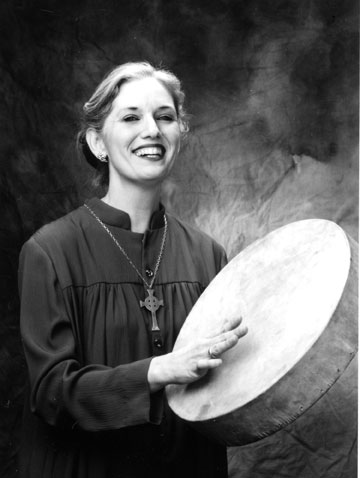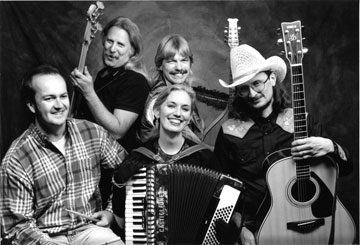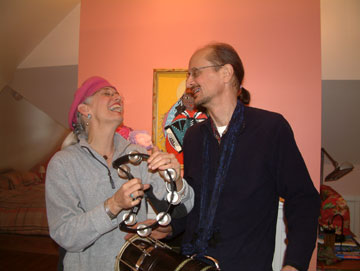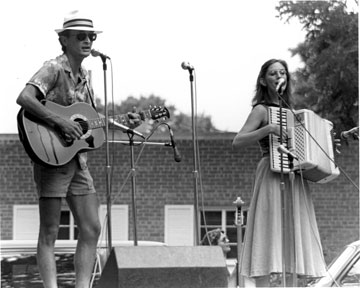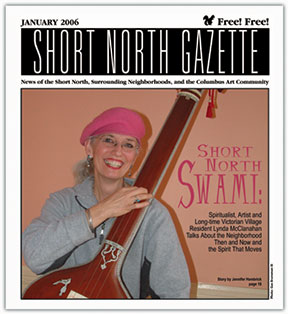
Columbus, Ohio USA
Return to Homepage www.shortnorth.com
Short North Swami
Spiritualist, artist and long-time Victorian Village resident Lynda McClanahan
talks about the neighborhood
then and now and the spirit that moves
January 2006
by Jennifer Hambrick
Return to Features Index
Lynda McClanahan On a chilly November afternoon spiritualist, musician and artist Lynda McClanahan greets me at the door of the Victorian Village townhouse she shares with her husband, Joel Knepp. McClanahan steps aside to let me in, revealing a large, colorful painting of what appears to be an Indian goddess clothed in a sari and seated in lotus position. Gina, a gray-and-white mottled cat, appears magically on the seat of a nearby chair. McClanahan leads me past a shrine of figurines of the Virgin Mary and other female forms, through another small room inhabited by guitars, drums and an old upright piano, and into the kitchen, where she, Knepp and I take our seats around a modest table.
The townhouse has that comfortable, lived-in feel that a home gets only after it is well acquainted with the people who live in it. Having lived in the area for most of the last 30 years, McClanahan, 53, has seen her neighborhood on the cusp of Harrison West go through unimagined transformations and has watched the greater Short North area literally grow up around her, taking it all in as the ever-changing scenery of her own unique spiritual journey.A Spiritual Odyssey
Born in Cincinnati, McClanahan was raised in a Presbyterian family and attended the University of Cincinnati College-Conservatory of Music, earning a degree in music education.
While in college, McClanahan felt the need to explore spiritual traditions beyond that of her mainline Protestant upbringing. She studied briefly in Cincinnati at a Zen center affiliated with the Rochester Zen Center before moving to Columbus with her first husband.
Neither Zen nor McClanahan’s first move to Columbus was a good fit, however. McClanahan gave up her study of Zen, left Columbus in 1978 and lived in Chicago until 1980. When she returned to Columbus in 1980, she started attending In Our Midst, a local metaphysical church, and was pulled to the meditative aspects of the church’s worship practices.
“It was the first time I had been exposed to that side of spirituality,” McClanahan said. “It was very captivating and re-ignited an interest in meditation. The more I was exposed to it, the more captured I became by the whole thing.”
McClanahan entered into a disciplined program of meditation and reading spiritual books. At the same time, she began saying the rosary regularly, even though devotion to the Virgin Mary played virtually no role in her Presbyterian upbringing. Still, McClanahan says that even as a child she was drawn to Mary.
“I was always out in the garage making little altars and my mother was saying, ‘what are you doing out there?’”
As McClanahan broadened her spiritual expression by studying world religions, Mary continued to play a role in her practice of meditation. She made a habit of going to a local Catholic church daily during her lunch hour.
“I think that it was just a natural attraction to mantra that took the form of the rosary because that’s the only thing I knew about at that time that was repeated over and over again,” McClanahan said.
While saying the rosary one day, McClanahan experienced spontaneous tremors in her spine and powerful surges of energy running up her body to the top of her head. The symptoms recurred each time she meditated, often causing her to see dazzling and inexplicable displays of light. The physical experiences left McClanahan in what she describes as ‘emotional upheaval.’
“There weren’t any answers for it at In Our Midst and there weren’t any answers in a mainline Christian setting for what had happened,” McClanahan said. “I really didn’t understand what was happening and thought maybe I had a brain tumor.”
Neurological tests revealed nothing abnormal. But a congregant at In Our Midst directed her to a local Syda (Siddha) Yoga group. During her study of yoga, McClanahan learned that her symptoms were part of what yoga practitioners call a kundalini experience. Kundalini, commonly understood as cosmic energy or energy of God, is thought to reside in an unawakened state at the base of the spine. But when that energy is awakened, an individual can have any number of physical experiences, including tremors.
Honky-Tonk Angel, mid '90s. Front Row L-R: John Souder, Lynda McClanahan, Joel Knepp. Back Row: Steve Harper, Jaycee Schnaars McClanahan studied with Syda Yoga for five years and was introduced in that time to kirtan, a call-and-response mode of chanting, as a means of meditating. During this time, McClanahan continued to attend In Our Midst, eventually becoming an ordained minister in that church and serving as its associate pastor. Her formal role within the church led her to pursue further training in divinity.
“The culture of that church is all intuition and off-the-cuff and so it was fine for me to be uneducated,” McClanahan said, “but I wanted to go to school.”
McClanahan enrolled in the Master of Sacred Theology degree program at the Methodist Theological School in Ohio (METHESCO). Not a believer in mainline Protestant theologies, McClanahan says many aspects of her experience at METHESCO were difficult.
“The big hang-up for me was that there was no room for the feminine aspect of God,” McClanahan said. “I was very shocked about that. The turning point for me at METHESCO was a theology class where the professor just outright said, ‘There is no feminine aspect of God.
Get over it.’”
But the point of no return was the disapprobation of McClanahan’s METHESCO classmates to a paper she wrote claiming that the Virgin Mary was the Christian equivalent of the goddess.
“There was such a negative response to that idea that I came home that night and said ‘This isn’t it. I can’t stay here,” McClanahan said. “I felt my heart was broken at METHESCO. It was a wonderful experience in many ways, but I explored the mainline Christian theology in a serious way and I had to leave home.”
That same evening she found an ad in a magazine for a distance-learning course offered through the Kriya Yoga Temple of Chicago. In 2003, McClanahan was ordained a Kriya yoga swami, in this capacity taking on the name Mirananda, after the Hindu saint Mirabai, who focused her devotional activity on singing ecstatic songs to God. McClanahan says accepting the title of swami from the Kriya Yoga Temple of Chicago does not certify her as an expert on Hindu philosophy. Still, she says her three years of Kriya yoga study gave her more than a title and filled the needs that her experience at METHESCO did not.
“I was allowed access to the mother. I could openly worship the mother. That meant a lot to me. I worship the goddess, in whatever form.”
With the title of swami came responsibilities to others.
“We were supposed to study Hatha yoga,” McClanahan said, “we had to take a vow to study yoga philosophy the rest of our lives and we were also enjoined to serve the community, to teach somehow.”
McClanahan fulfills the service requirement in a number of ways. Since 2004 she has given spiritual messages at local New Thought metaphysical churches and has given workshops at other venues on different aspects of spirituality. An upcoming workshop on February 12 at Pickerington’s Unity Church East on the yoga of devotion will introduce people to the idea of ritual devotional practices like chanting or meditation and using them as a way to expand consciousness. McClanahan also serves as an officiant at weddings for couples who want spiritual weddings outside the context of mainline churches. For the last ten years, she has combined her spiritual background with her training in music education by holding annual yoga chants under the Blue Hand Yoga Group banner. The chants, which are open to the community, combine traditional Hindu kirtan with an eclectic mix of Western and Indian instruments.
McClanahan’s yoga studies have taken her to India twice. A stout admirer of Hindu philosophy, she has many times considered converting to Hinduism, but each time has shied away from taking the final step, wondering, “How does a Western person be a Hindu?”
A Devoted Civil Servant
One could say that McClanahan and the greater Short North area have been on parallel paths. As McClanahan was embarking on her spiritual journey in the late 1970s, the Short North and surrounding neighborhoods also were beginning their transformations from working-class neighborhoods and run-down High Street commercial strip to the upscale historic neighborhoods and vibrant arts district they are today.
McClanahan remembers what the area was like when she first came to town and has seen all of Columbus change dramatically.
“When I first got to Columbus in winter of ‘74, spring of ‘75, the place was so different from Cincinnati,” McClanahan said. “It was a real small town. I felt marooned up here, but the place has changed so much, so now it’s home. I think Columbus is a very special place, very powerful place. And I really, really like this neighborhood.”
When she and Knepp moved into their home on the border of Victorian Village and Harrison West in 1984, McClanahan says her neighbors were mostly African-American working people, whom she remembers fondly.
“We were warmly, warmly welcomed,” McClanahan said.
A recent photo of Lynda and her husband Joel Knepp.
Photo by Gus Brunsman IIIOver the years, many of McClanahan’s neighbors have aged or died or moved away and she has watched these changes transform her neighborhood.
“The neighborhood is a lot more middle to upper class now,” McClanahan said. “Now our neighbors are mostly younger than us. When we moved in we were the young ones, and now we’re the older ones. Our African-American neighbors had families. Now, it seems when people move into the neighborhood, they have kids, but when they reach school age, they generally move on. I miss that sort of down-home friendliness that was here when we moved in. The people were more interesting to me. I just found them interesting and their stories fascinating. Joel and I got along with everybody.”
The changes in the neighborhood’s demographics have coincided with other changes in the area, some of which are considered to be improvements. But these improvements have come at a cost that McClanahan laments.
“The neighborhood is prettier now, and I think it’s safer now,” McClanahan said. “Housing values have gone crazy. People tell us that we’re supposed to be really happy about this, but when we moved here, our taxes were $300 a year. But I hate to see people of more modest means being squeezed out of the neighborhood. They have a witness for the rest of society that is important to have – that you can get along with less.”
However, McClanahan sees less to lament about the growth of the Short North into its current district of art galleries and fashionable boutiques.
“We used to shop at the Big Bear at Neil and Buttles. Their idea of a nice display was a huge pyramid of lard buckets,” McClanahan laughed. “It used to be that the only things to do at night were up at colleges. There was no ‘scene’ and there were no cafés. Now, the Short North is a pearl. It’s lovely being able to walk to lots of nice restaurants and coffee shops.
We could get rid of our car tomorrow and we’d get along fine.”
Still, McClanahan is worried that the High Street galleries in the Short North will go the way of her former Victorian Village neighbors.
“I’m concerned about the galleries, that they are being forced out,” McClanahan said. “At 4th Street and High there was a gallery called the Easton Art Gallery and then there was Acme Art Company, but Acme was forced out by the rents. I really like the idea of having an arts district, but it might have to be subsidized to keep it.”
Of course, without galleries, there would be no Gallery Hops. McClanahan and Knepp have literally watched the Gallery Hops grow into the stunning displays of humanity and invention they are today. They appeared for more than a decade at Gallery Hops as the musical act Nick and Polina, performing accessible rock and pop standards from the 1940s and ‘50s on accordion and guitar. McClanahan remembers a time when the only street musicians around town were the Turkeys in the Straw, who played every now and then outside the state office towers downtown. She hopes the Gallery Hop tradition will continue to provide a forum for the creative and the unexpected.
Lynda and her husband appeared for more than a decade at Galley Hops
as the musical act Nick and Polina. Here they are at a folk festival in 1983.“I think it’s fabulous,” McClanahan said. “I love the street musicians. And there are vendors that set up just for that night, so that gives small business people and artists an opportunity to show their stuff. The last time I did the Gallery Hop a troupe of tribal belly dancers showed up. The Gallery Hops provide a stage for spontaneous expression and for something unscripted to happen. I don’t know how Columbus got that, or how it happened. It seems almost more European to me.”
Even if Short North institutions like the galleries and the monthly Gallery Hops stay, McClanahan, like many Short North area residents, hopes to see more shops providing day-to-day necessities in the area.
“I personally would like to have a little hardware store, shoe repair shops,” McClanahan said. “That kind of thing in the Short North has disappeared. There’s a lot of upscale shopping, but if you want to buy a hammer, you’re going to have to go to Grandview.”
In addition to her participation in the Gallery Hops, McClanahan also has volunteered for other area organizations. Since 2003 she and Knepp have been active members of Friends of Goodale Park. But for years before then, during a less fortunate period in the park’s history, they picked up litter and tended the flower beds in front of the statue of Lincoln Goodale.
“We feel that park is a jewel,” McClanahan said. “In the ‘70s the park used to be very neglected like it was completely forgotten, and people didn’t use it much. Now people use it all the time and it looks so nice. The reason that park looks so nice is because of the volunteers. But there’s also a little bit of guerrilla gardening that goes on in the park. There’ll be a bush that sort of appears and a bed that someone appropriates.”
In addition to their official duty as Friends of Goodale Park to tend the flower beds in front of the statue of Lincoln Goodale, McClanahan and Knepp have done a little “guerrilla gardening” themselves in the park, planting perennials and bulbs along the river and the odd cluster of trees here and there, all in the name of enhancing the beauty of the park.
Columbus sculptor Malcolm Cochran hopes his design for the fountain to be installed in the Goodale Park lake also will beautify the park. Like other Short North area residents, McClanahan says she was initially skeptical about Cochran’s design, but has decided to trust the committee of experts who selected Cochran’s plan.
“I think there’s a tendency to want statues of Greek gods or something old fashioned,” McClanahan said. “I think something that has a little edge and is creative is good. So I’ve changed my mind about it. It’s so easy to gripe and say ‘I don’t like that.’ We’re lucky to have so many people who are so interested in making it beautiful – and people who value beauty – and that uplifts all of us.”
The Artist in Her
McClanahan’s concern for the beauty of Goodale Park comes naturally. Along with her spiritual exploration came an explosion of creative energy and a true mandate that it be manifested in visual artwork.
“Someone appeared to me in a dream and told me that if I did not start creating art, I would die,” McClanahan said.
So McClanahan picked up her paintbrush. Her home shows the results of an ensuing period of intense creativity. Light floods through the windows of the townhome’s airy second floor, illuminating a veritable gallery of paintings cast in simple, almost primitive lines and bold colors. One painting depicts a snake, an image that also came to McClanahan in a dream. Through her yoga studies McClanahan has learned that the serpent is a symbol of kundalini – the divine energy that had appeared with such force within her almost twenty years ago.
McClanahan’s art has been exhibited at several Short North galleries and at other local venues through the Liturgical Art Guild. She is currently working in three-dimensional forms but says the medium in which she works at any given time is dictated solely by the creative impulse. Once, she went through a phase of painting wooden paint stirrers and decorating them with découpage and glitter. McClanahan says she has no idea why she felt compelled to create these pieces. “I don’t know what it was – you can’t sell anything like that, so why did I make it?” But she obeys her muse, as a good servant obeys her master.
“I think all artists are driven to fill the world with beauty somehow – beautiful music, beautiful pictures, whatever,” McClanahan said. “We’re really kind of slaves to beauty.”
In this upstairs gallery, a gentle Siamese cat named Monkey emerges from beneath a chair and completes his stretches with the serpentine fluidity of the snake in McClanahan’s painting. This graceful feline yoga reminds me of Gina’s ghost-like appearance downstairs at the beginning of our interview. I depart the townhouse content that my visit has come full circle, maybe like the never-ending essence of infinity itself.Visit www.lyndamcclanahanart.com
©2006 Short North Gazette, Columbus, Ohio. All rights reserved.
